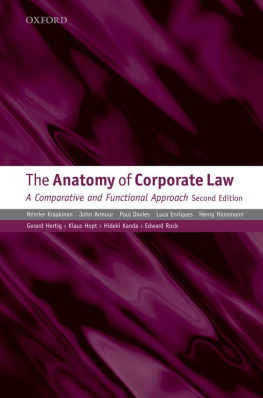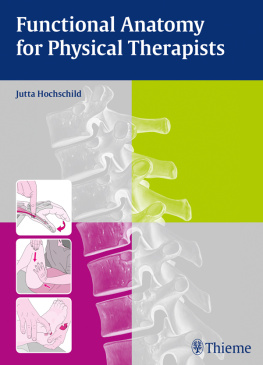THE ANATOMY OF CORPORATE LAW
A COMPARATIVE AND FUNCTIONAL APPROACH
The Anatomy of Corporate LawA Comparative and Functional Approach
Second Edition
REINIER KRAAKMAN
JOHN ARMOUR
PAUL DAVIES
LUCA ENRIQUES
HENRY HANSMANN
GERARD HERTIG
KLAUS HOPT
HIDEKI KANDA
EDWARD ROCK


Great Clarendon Street, Oxford OX 2 6 DP
Oxford University Press is a department of the University of Oxford. It furthers the Universitys objective of excellence in research, scholarship, and education by publishing worldwide in
Oxford New York
Auckland Cape Town Dar es Salaam Hong Kong Karachi
Kuala Lumpur Madrid Melbourne Mexico City Nairobi
New Delhi Shanghai Taipei Toronto
With offices in
Argentina Austria Brazil Chile Czech Republic France Greece
Guatemala Hungary Italy Japan Poland Portugal Singapore
South Korea Switzerland Thailand Turkey Ukraine Vietnam
Oxford is a registered trade mark of Oxford University Press
in the UK and in certain other countries
Published in the United States
by Oxford University Press Inc., New York
R. Kraakman, J. Armour, P. Davies, L. Enriques, H. Hansmann, G. Hertig, K. Hopt, H. Kanda, and E. Rock, 2009
The moral rights of the authors have been asserted
Crown copyright material is reproduced under Class Licence
Number C01P0000148 with the permission of OPSI
and the Queens Printer for Scotland
First published 2009
All rights reserved. No part of this publication may be reproduced, stored in a retrieval system, or transmitted, in any form or by any means, without the prior permission in writing of Oxford University Press, or as expressly permitted by law, or under terms agreed with the appropriate reprographics rights organization. Enquiries concerning reproduction outside the scope of the above should be sent to the Rights Department, Oxford University Press, at the address above
You must not circulate this book in any other binding or cover
and you must impose the same condition on any acquirer
British Library Cataloguing in Publication Data
Data available
Library of Congress Cataloging-in-Publication Data
The anatomy of corporate law: a comparative and functional approach / Reinier
Kraakman [et al.].2nd ed.
p. cm.
Includes index.
ISBN 9780199565832 (hardback : alk. paper)
ISBN 9780199565849 (pbk. alk. paper)
1. Corporation law. I. Kraakman, Reinier H.
K1315.A53 2009
346.066dc22 2009023537
Typeset by Newgen Imaging Systems (P) Ltd., Chennai, India
Printed in Great Britain
on acid-free paper by
Clays Ltd, St Ives plc
ISBN 9780199565832 (Hbk.)
ISBN 9780199565849 (Pbk.)
1 3 5 7 9 10 8 6 4 2
Acknowledgements
In preparing this second edition we have had the great benefit of the efforts of the reviewers of our first edition. We should like to mention in particular the review by David Skeel (Corporate Anatomy Lessons 113 Yale Law Journal 1519, 2004), from which we learned much, but many reviewers provided insightful comment, which we have tried to take into account.
The process of preparing the second edition was eased by the hospitality which we jointly enjoyed from, in chronological order, New York University Law School, ETH (Zurich), and Yale Law School.
As with the first edition, we have drawn shamelessly on our friends and colleagues for comment on various parts of the book. We list them here and apologize in advance to any whom we have omitted: Marcello Bianchi, Christophe Clerc, Pierre-Henri Conac, Matteo Gargantini, Martin Gelter, Jesse Fried, Henry Hu, Joe McCahery, Federico Mucciarelli, Peter Mlbert, Martine Kloepfer Pelse, Alain Pietrancosta, Paolo Santella, Rolf Skog, Lorenzo Sasso, Lorenzo Stanghellini, Erik Vermeulen, Dirk A. Zetzsche, and Andrea Zorzi.
Once again, we should like to thank our home institutions for providing financial support to us personally as we worked on this book. We thank the University of Oxford for funding John Armour; the London School of Economics and Political Science for funding Paul Davies and Laura Laborey for research assistance; the Yale Law School for funding Henry Hansmann; the ETH for funding Gerard Hertig; the Harvard Law School John M. Olin Center for Law, Economics, and Business for funding Reinier Kraakman and Alexander Hellgardt and Kaoru Matsuzawa for research assistance; and the Saul Fox Research Endowment for funding Ed Rock.
As ever, we thank our nearest and dearest, who may legitimately wonder why such a short book has involved so much toing and froing.
The Authors
Preface
This book results from a longstanding collaboration among nine authors from six countries, and many more colleagues from around the world who have provided helpful suggestions and criticisms, both for the First Edition and for this, the Second Edition, of The Anatomy of Corporate Law. All of usthe authorshave taken principal responsibility for particular chapters of the book, but each of us has also contributed to the structure and content of the entire book. The First Edition of this book took nine years to complete. The Second Edition took less than three, thanks in large part, to the energy and fresh vision of the two new authors who joined our team to rework the Anatomy: John Armour, of Oxford University, and Luca Enriques, of CONSOB and the University of Bologna.
As with the First Edition, we can best summarize this book with four words: it is international, functional, neutral, and, not least, it is short. It is international because its authors hail from different jurisdictions, and because it is predicated on the idea of a field of corporateor companylaw, with problems and legal strategies that, at a mid-level of abstraction at least, are independent of the laws of specific jurisdictions. Naturally, we must address particular national corporate laws to make this idea compelling. We therefore focus the book on corporate law in six core jurisdictions: France, Germany, Italy, Japan, the UK, and the U.S. But to the extent that we provide an integrated analysis of the company laws of these jurisdictions, we also provide an analytical framework for investigating corporate law across all jurisdictions.
The framework we develop is also functional. By this we mean that our book highlights the economic logic of corporate law. The corporate form, and the law to which it gives rise, are utilitarian institutions, which must be understood in the first instance in the light of their economic contributions to business life. Of course this point should not be exaggerated. This books authors do not believe that every aspect of corporate law is economically rational, still less that any particular corporate law is optimal. Politics and path dependence affect the law in every jurisdiction, as do the larger legal and business culture in which corporate law operates. Moreover, there are momentsand the financial crisis of 20072009 may be one of themwhen the future development of corporate law (and of other forms of business regulation) seems especially uncertain. New insight into the interaction of markets and regulation may result in more functional company law, especially in the case of listed companies and financial institutions. Alternatively, the spotlight cast by the financial crisis on matters ranging from executive compensation to limits on directorial liability in the face of staggering financial losses may lead to legal changes that can only be explained as populist backlash. Naturally we hope for the former outcome, and not only because our analytical framework highlights the laws economically rational elements.
Next page













